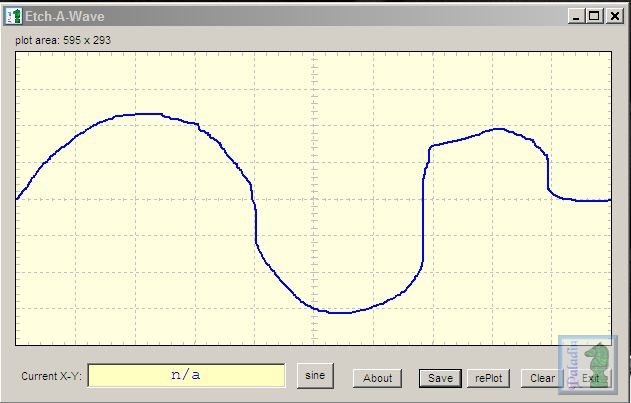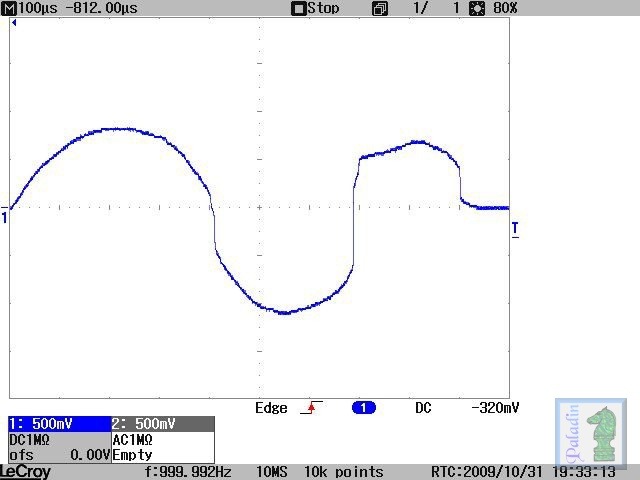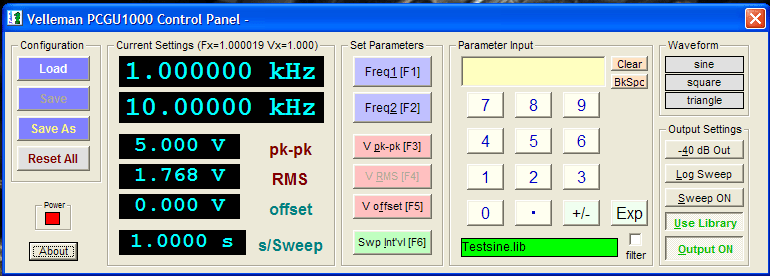Sure. From the specs it sounds like many other similar low cost generators. Even some expensive ones. They usually have a slight peak on the top and bottom of the sine wave, since they generate a triangle and then round it off to form the sine wave. IOW, don't expect really low distortion, but it will work fine for frequency response and looking at square wave response on the scope. Many can sweep, so you can do visual response curves for filters and such on the scope.
CH
CH
One issue for audio work is that function generators tend to have pretty crappy distortion specs for their sine wave outputs--also, (and this is 100% IMHO) the Victor instruments tend to be crap. I have a Victor VC-3165 counter that I wish I'd not bought--fortunately it only cost $50 and it to does work well to monitor the frequency of my pirate FM station.
The VC-2002 sine wave THD is specified as being "-40 dBc" (40 dB below the set frequency's level), this is 1.0% THD which is not even close to being a clean enough source for serious audio work.
Look for older low distortion RC oscillators like the Kikusui ORC-11 (0.002% THD) and it's clones. The Leader LAG-120B and LAG-126 (0.005% THD) also often appear on eBay.
I have a Kikusui ORC-11 and it's output from 10Hz to 50kHz is < 0.0019% THD...
The VC-2002 sine wave THD is specified as being "-40 dBc" (40 dB below the set frequency's level), this is 1.0% THD which is not even close to being a clean enough source for serious audio work.
Look for older low distortion RC oscillators like the Kikusui ORC-11 (0.002% THD) and it's clones. The Leader LAG-120B and LAG-126 (0.005% THD) also often appear on eBay.
I have a Kikusui ORC-11 and it's output from 10Hz to 50kHz is < 0.0019% THD...
I have a Kikusui ORC-11 and it's output from 10Hz to 50kHz is < 0.0019% THD...
What kind of waves does it to?
What kind of waves does it to?
Sine and square, it's an audio signal generator not a function generator--as I said function generator's tend to have relatively poor distortion specs...

PC sound card based instrument's can be useful for audio work, however their output is only as good as the sound card itself--and while most sound card's have low audio distortion they will also produce ultrasonic artifacts of the sampling frequency, and have lower level outputs in the range of 1.0V RMS or so.
A "not too bad" and inexpensive instrument is the Velleman PCGU1000 function generator, it's THD is less than 0.08% across the audio band. Here's a review I did just after I got one...
Thanks. The price of the Kikusui is a bit out of my range.
I exlcuded soundcards, that even they may be pretty good, but even good software such as Spectra plus is limited to 22050hz. What I need the most is a FAST HF square wave (20khz to 100khz min.)
Have you measured the rise time of the Kikusui and of the Velleman?
I exlcuded soundcards, that even they may be pretty good, but even good software such as Spectra plus is limited to 22050hz. What I need the most is a FAST HF square wave (20khz to 100khz min.)
Have you measured the rise time of the Kikusui and of the Velleman?
Here are screen shots of the PCGU1000 and ORC-11 20%-80% and 10%-90% risetimes.
The PCGU1000 is not bad at 14.66ns (10%-90%), however the ORC-11's performance is not impressive as fast rise time was compromised for low-distortion...
PCGU1000:

ORC-11:

As to sound card instruments, and please I do not mean to offend proponents of same, there is no way you will get either a decent looking, or fast rise time square wave from even the best of the breed.
Here is the rise time for a 48kHz sample rate, created with a reasonably good Creative USB "card":

16.06us, or over 1000 times slower than the PCGU1000. Granted this is a 48kHz card, however even with a 192kHz card you'd be lucky to get rise times of 3-4us.
Here's what the full wave looks like:

By contrast here is the full wave from the PCGU1000:

The PCGU1000 is not bad at 14.66ns (10%-90%), however the ORC-11's performance is not impressive as fast rise time was compromised for low-distortion...
PCGU1000:

ORC-11:

As to sound card instruments, and please I do not mean to offend proponents of same, there is no way you will get either a decent looking, or fast rise time square wave from even the best of the breed.
Here is the rise time for a 48kHz sample rate, created with a reasonably good Creative USB "card":

16.06us, or over 1000 times slower than the PCGU1000. Granted this is a 48kHz card, however even with a 192kHz card you'd be lucky to get rise times of 3-4us.
Here's what the full wave looks like:

By contrast here is the full wave from the PCGU1000:

There are programmable signal generators that are basically just ring buffers (loaded with whatever waveform you can fit inside and clocked at whatever frequency the PLL is capable of running at) connected to DACs. The HP/Agilent units at my university are that type and they produce a very clean signal. But they're probably way too expensive for your application. It should be easy to build something a little less elaborate out of a microcontroller and high speed DAC.
There are programmable signal generators that are basically just ring buffers (loaded with whatever waveform you can fit inside and clocked at whatever frequency the PLL is capable of running at) connected to DACs. The HP/Agilent units at my university are that type and they produce a very clean signal. But they're probably way too expensive for your application. It should be easy to build something a little less elaborate out of a microcontroller and high speed DAC.
Not expensive at all, they cost (used of course) less than the 600$ of the ORC-11.
I'm checking some datasheet, raise time seems to be usually around 20ns and distortion <0.01% iirc.
Looks like the Vellerman is really a best buy.
The PCGU1000 can also function as an arbitrary wave generator, in fact quite arbitrary--here is an Etch-A-Wave application I created for a client:

Here is the created wave, as reproduced by the PCGU1000:

Waveforms can also be captured from other instruments capable of exporting CSV of other usable data files, converted to the PCGU1000 wave library format, and then reproduced at any desired frequency by the PCGU'.
Here's the entire waveform library file for a 10% duty cycle square wave:
It does full negative output (0.5 * [pk-pk setting] * -1) for 7200 counts, then do an immediate change (the (0) instruction tells it this) to full positive output for 800 counts.
A five-step staircase would be:
If you get one you may like to use the alternate front-end I developed, based in part upon my late departed WaveTek 1288's front panel:


Here is the created wave, as reproduced by the PCGU1000:

Waveforms can also be captured from other instruments capable of exporting CSV of other usable data files, converted to the PCGU1000 wave library format, and then reproduced at any desired frequency by the PCGU'.
Here's the entire waveform library file for a 10% duty cycle square wave:
Code:
-1.0 (7200)
(0)
1.0 (800)
(0)It does full negative output (0.5 * [pk-pk setting] * -1) for 7200 counts, then do an immediate change (the (0) instruction tells it this) to full positive output for 800 counts.
A five-step staircase would be:
Code:
-1 (1500)
(0)
-0.5 (1500)
(0)
0 (1500)
(0)
0.5 (1500)
(0)
1 (1500)
(0)If you get one you may like to use the alternate front-end I developed, based in part upon my late departed WaveTek 1288's front panel:

Yes, I'm seriously thinking getting the Velleman. Do you know any european dealer?
I have no means (yet) to measure the distortion, besides of the very same pc. My soundcard (infrasonic quartet), though is similar in quality to the rather famous juli@ and both should be several times to anything made by creative.
I have no means (yet) to measure the distortion, besides of the very same pc. My soundcard (infrasonic quartet), though is similar in quality to the rather famous juli@ and both should be several times to anything made by creative.
Yes, I'm seriously thinking getting the Velleman. Do you know any european dealer?
I have no means (yet) to measure the distortion, besides of the very same pc. My soundcard (infrasonic quartet), though is similar in quality to the rather famous juli@ and both should be several times to anything made by creative.
Velleman's main office and plant is in Belgium...
The problem with square wave generation from a sound card is the low sampling rate. measured in kHz, not mHz (the PCGU1000 uses a 50MHz clock). This also affects sine waves as the wave frequency nears and passes 1/5 the sample rate.
At 192kHz sample rate the very best 10%-90% rise time one could generate would be (1/192k) * 0.8, or 4.1us, which is rather leisurely. A 20kHz sine wave generated at a 192kHz sample rate is defined by 9 samples--this is fine for listening to audio as the human ear cannot hear the distortion but look at a 20kHz wave form a sound card on a 100MHz scope and you will see it's not pretty.
Last edited:
- Status
- This old topic is closed. If you want to reopen this topic, contact a moderator using the "Report Post" button.
- Home
- Design & Build
- Equipment & Tools
- Function Generator